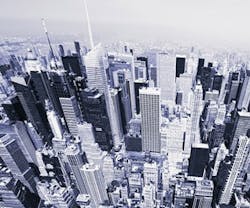White Roofs May Successfully Cool Cities
Painting roofs white has the potential to significantly cool cities and mitigate some impacts of global warming, a new study indicates. The new NCAR-led research suggests there may be merit to an idea advanced by U.S. Energy Secretary Steven Chu that white roofs can be an important tool to help society adjust to climate change.
The study team, led by scientists at the National Center for Atmospheric Research (NCAR), cautions that there are still many hurdles between the concept and actual use of white roofs to counteract rising temperatures.
"Our research demonstrates that white roofs, in theory, can be an effective method for reducing urban heat," says NCAR scientist Keith Oleson, the lead author of the study. "It remains to be seen if it's actually feasible for cities to paint their roofs white, but the idea certainly warrants further investigation."
The study team used a newly developed computer model to simulate the amount of solar radiation that is absorbed or reflected by urban surfaces. The model simulations, which provide scientists with an idealized view of different types of cities around the world, indicate that, if every roof were entirely painted white, the urban heat island effect could be reduced by 33 percent. This would cool the world's cities by an average of about 0.7 degrees F., with the cooling influence particularly pronounced during the day (especially in the summer).
In the real world, the cooling impact might be somewhat less because dust and weathering would cause the white paint to darken over time, and parts of roofs would remain unpainted because of openings such as heating and cooling vents.
In addition, white roofs would have the effect of cooling temperatures within buildings. As a result, depending on the local climate, the amount of energy used for space heating and air conditioning could change, which could affect outside air temperatures and the consumption of fossil fuels, such as oil and coal, that are associated with global warming. Depending on whether air conditioning or heating is affected more, this could either magnify or partially offset the impact of the roofs.
The research indicated that some cities would benefit more than others from white roofs, depending on:
-
Roof density. Cities where roofs make up more of the urban surface area would cool more.
-
Construction. Roofs that allow large amounts of heat from the sun to penetrate the interior of a building (as can happen with metal roofs and little insulation) are less effective in cooling outside temperatures when painted white.
-
Location. White roofs tend to have a larger impact in relatively warm climates that receive strong, year-round sunlight.
